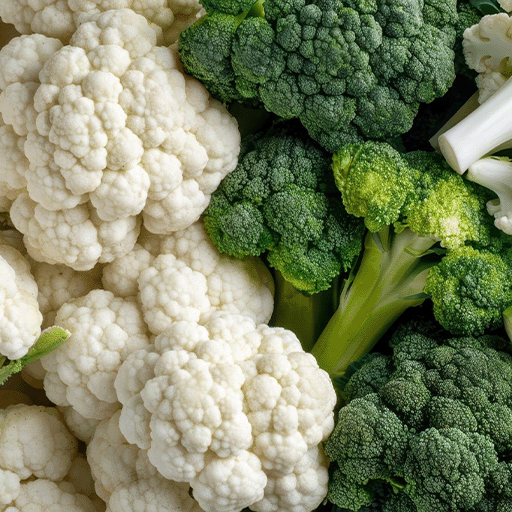
CDP-CHOLINE
CDP-Choline, or citicoline, is naturally found in foods like cruciferous vegetables, eggs, and meat. It promotes attention, memory, and focus by boosting acetylcholine levels and enhancing neurotransmitter function.
CDP-CHOLINE
CDP-Choline, also called citicoline, is converted to choline when consumed. Choline is an essential nutrient found in eggs, meat, chicken, broccoli, cauliflower, and partly in beans, nuts, and seeds. Choline helps your brain create more of the neurotransmitter acetylcholine [8], which is important for memory, learning, attention, and even moving your muscles.
Having unbalanced levels of acetylcholine is linked to Alzheimer’s disease and Parkinson’s disease [1, 2], which makes sense due to it’s role in memory & movement. People with Alzheimer’s or mixed dementia who supplemented with citicoline had greater cognitive performance than those that didn’t [3, 7]. In general, citicoline may be effective at preventing cognitive decline [3, 11]. For elderly individuals with poor memory (not dementia), citicoline supplementation had a significant improvement to memory performance [12, 13].
In healthy adults, supplementing with citicoline resulted in stronger overall attention [4, 5, 9], improved memory, and faster learning [9]. Younger individuals aged 13-18 years old supplemented with citicoline for 28 days and demonstrated significantly better attention and reduced impulsivity [6].

Composite memory scores after 12 weeks of supplementing with citicoline were significantly better than those who did not supplement [4].
People who consume higher levels of choline tend to have lower risks of strokes, cardiovascular disease [16], cognitive impairment, and dementia [17]. Those that consume lower levels of choline may also be missing out on significant gains from strength training [18, 19].
Choline supplements are often taken during pregnancy and early childhood, which has been researched to prevent neural tube defects and improve memory, attention, and visuospatial learning [15].
If you’d like to learn more, this detailed review paper on citicoline is the most comprehensive and uses 871 references [8].
How?
CDP-Choline when ingested is quickly converted to choline, which is synthesized into the neurotransmitter acetylcholine [14]. Part of CDP-Choline is also converted into uridine, which is used for the synthesis of DNA, RNA, and other various components [14].
The neurotransmitter acetylcholine plays an important role in memory, learning, attention, and more. Having low levels of acetylcholine will impede these functions, but having healthy levels will boost their performance.
Dosage
Supplementing with 250 mg for 28 days showed significant improvements to memory tests in healthy adults, but 500 mg was only trending (not significant) [5]. Up to 1000 mg daily has been tested with no serious side effects [7], indicating it is well tolerated and safe.
CDP-Choline is absorbed and utilized in the brain almost immediately and this increase in choline can last up to 6 hours [8].
Too much acetylcholine in the brain can be dangerous and cause nausea. That is why if you’re a healthy adult you’ll likely want to avoid any supplements that include huperzine A, which prevents the breakdown of acetylcholine. The half-life of huperzine A is 10-14 hours [20], so if you take it daily it can accumulate and build up to dangerous levels. ANOO has strict standards and never uses potentially dangerous ingredients that require cycling.
Benefits
- Supports attention [5, 6, 9, 10]
- Supports memory performance [4, 9, 12]
- Helps prevent cognitive decline [3, 7, 11]
- Helps reduce impulsivity [6, 9]
- Supports faster learning [9]
- May prevent significantly diminished gains in strength training [18]
References
[1] https://pubmed.ncbi.nlm.nih.gov/16273023/
[2] https://pubmed.ncbi.nlm.nih.gov/56538/
[3] https://pubmed.ncbi.nlm.nih.gov/36678257/
[4] https://pubmed.ncbi.nlm.nih.gov/33978188/
[5] http://dx.doi.org/10.4236/fns.2012.36103
[6] https://pubmed.ncbi.nlm.nih.gov/26179181/
[7] https://pubmed.ncbi.nlm.nih.gov/10669911/
[8] https://pubmed.ncbi.nlm.nih.gov/36544369/
[9] https://pubmed.ncbi.nlm.nih.gov/25046515/
[10] https://pubmed.ncbi.nlm.nih.gov/22578105/
[11] https://doi.org/10.17756/jnen.2019-047
[12] https://pubmed.ncbi.nlm.nih.gov/9203170/
[13] https://pubmed.ncbi.nlm.nih.gov/8624220/
[14] https://www.ncbi.nlm.nih.gov/books/NBK11143/
[15] https://pubmed.ncbi.nlm.nih.gov/36041182/
[16] https://pubmed.ncbi.nlm.nih.gov/37764819/
[17] https://pubmed.ncbi.nlm.nih.gov/31360988/
[18] https://pubmed.ncbi.nlm.nih.gov/37764658/
[19] https://pubmed.ncbi.nlm.nih.gov/36629089/
[20] https://pubmed.ncbi.nlm.nih.gov/18348466/
